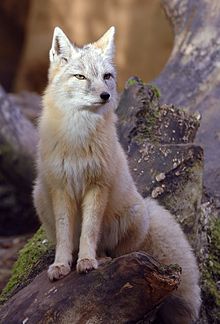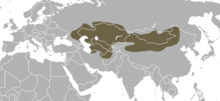
Canidae is a biological family of dog-like carnivorans, colloquially referred to as dogs, and constitutes a clade. A member of this family is also called a canid. The family includes three subfamilies: the Caninae, the extinct Borophaginae and Hesperocyoninae. The Caninae are known as canines, and include domestic dogs, wolves, coyotes, foxes, jackals and other species.

The fennec fox is a small crepuscular fox native to the deserts of North Africa, ranging from Western Sahara and Mauritania to the Sinai Peninsula. Its most distinctive feature is its unusually large ears, which serve to dissipate heat and listen for underground prey. The fennec is the smallest fox species. Its coat, ears, and kidney functions have adapted to the desert environment with high temperatures and little water. It mainly eats insects, small mammals and birds. The fennec has a life span of up to 14 years in captivity and about 10 years in the wild. Its main predators are the Verreaux's eagle-owl, jackals and other large mammals. Fennec families dig out burrows in the sand for habitation and protection, which can be as large as 120 m2 (1,300 sq ft) and adjoin the burrows of other families. Precise population figures are not known but are estimated from the frequency of sightings; these indicate that the fennec is currently not threatened by extinction. Knowledge of social interactions is limited to information gathered from captive animals. The fennec's fur is prized by the indigenous peoples of North Africa, and it is considered an exotic pet in some parts of the world.
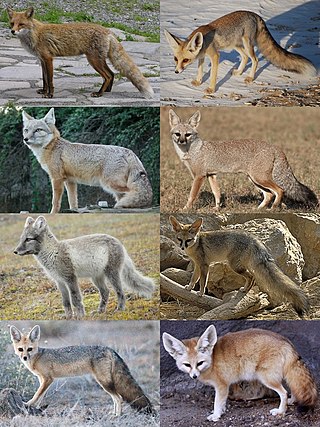
Vulpes is a genus of the sub-family Caninae. The members of this genus are colloquially referred to as true foxes, meaning they form a proper clade. The word "fox" occurs in the common names of all species of the genus, but also appears in the common names of other canid species. True foxes are distinguished from members of the genus Canis, such as domesticated dogs, wolves, jackals and coyotes, by their smaller size (5–11 kg), longer, bushier tail, and flatter skull. They have black, triangular markings between their eyes and nose, and the tip of their tail is often a different color from the rest of their pelt. The typical lifespan for this genus is between two and four years, but can reach up to a decade.

The bat-eared fox is a species of fox found on the African savanna. It is the only extant species of the genus Otocyon and considered a basal canid species. Fossil records indicate this canid first appeared during the middle Pleistocene.

The kit fox is a fox species that inhabits arid and semi-arid regions of the southwestern United States and northern and central Mexico. These foxes are the smallest of the four species of Vulpes occurring in North America and are among the smallest of the vulpines worldwide. It has also been called a North American counterpart of the fennec fox due to its large ears.

The swift fox is a small light orange-tan fox around the size of a domestic cat found in the western grasslands of North America, such as Montana, Colorado, New Mexico, Kansas, Oklahoma and Texas. It also lives in southern Manitoba, Saskatchewan and Alberta in Canada, where it was previously extirpated. It is closely related to the kit fox and some mammalogists classify them as conspecific. However, molecular systematics imply that the two species are distinct. Interbreeding between the two species does occur where their ranges overlap, but this hybridization is quite restricted in scope.

The Cape fox, also called the asse, cama fox or the silver-backed fox, is a small species of fox, native to southern Africa. It is also called a South African version of a fennec fox due to its similarly big ears. It is the only "true fox" occurring in sub-Saharan Africa, and it retains primitive characteristics of Vulpes because it diverged early in the evolutionary history of the group.

The gray fox, or grey fox, is an omnivorous mammal of the family Canidae, widespread throughout North America and Central America. This species and its only congener, the diminutive island fox of the California Channel Islands, are the only living members of the genus Urocyon, which is considered to be genetically basal to all other living canids. Its species name cinereoargenteus means "ashen silver".

The hoary marmot is a species of marmot that inhabits the mountains of northwest North America. Hoary marmots live near the tree line on slopes with grasses and forbs to eat and rocky areas for cover.

The crab-eating fox, also known as the forest fox, wood fox, bushdog or maikong, is an extant species of medium-sized canid endemic to the central part of South America since at least the Pleistocene epoch. Like South American foxes, which are in the genus Lycalopex, it is not closely related to true foxes. Cerdocyon comes from the Greek words kerdo and kyon (dog) referring to the dog- and fox-like characteristics of this animal.
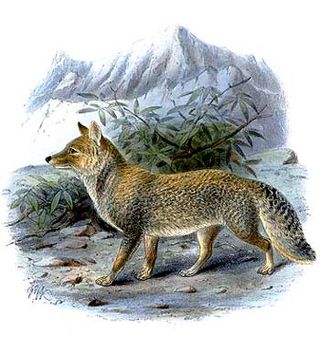
The Tibetan fox, also known as the Tibetan sand fox, is a species of true fox endemic to the high Tibetan Plateau, Ladakh plateau, Nepal, China, Sikkim, and Bhutan, up to elevations of about 5,300 m (17,400 ft). It is listed as Least Concern in the IUCN Red List, on account of its widespread range in the Tibetan Plateau's steppes and semi-deserts.

Blanford's fox is a small fox native to the Middle East and Central Asia. It is listed as Least Concern on the IUCN Red List.

The Sechuran fox, also called the Peruvian desert fox or the Sechuran zorro, is a small South American species of canid closely related to other South American "false" foxes or zorro. It gets its name for being found in the Sechura Desert in northwestern Peru.

The Pampas fox, also known as grey pampean fox, Pampas zorro, Azara's fox, or Azara's zorro, is a medium-sized zorro, or "false" fox, native to the South American Pampas. Azara in some of its alternative common names is a reference to Spanish naturalist Félix de Azara.
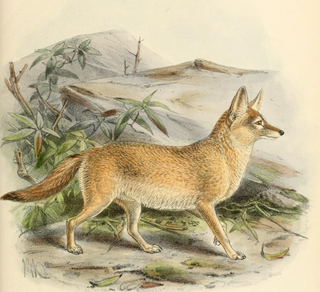
The pale fox is a species of fox found in the band of African Sahel from Senegal in the west to Sudan in the east. It is one of the least studied of all canid species, in part due to its remote habitat and its sandy coat that blends in well with the desert-like terrain.

Rüppell's fox, also called Rüppell's sand fox, is a fox species living in desert and semi-desert regions of North Africa, the Middle East, and southwestern Asia. It has been listed as Least Concern on the IUCN Red List since 2008. It is named after the German naturalist Eduard Rüppell.

The Caninae, known as canines, are one of three subfamilies found within the canid family. The other two canid subfamilies are the extinct Borophaginae and Hesperocyoninae. The Caninae includes all living canids and their most recent fossil relatives. Their fossils were first found in North America and dated to the Oligocene era, then spreading to Asia at the end of the Miocene era, some 7 million to 8 million years ago.

The red fox is the largest of the true foxes and one of the most widely distributed members of the order Carnivora, being present across the entire Northern Hemisphere including most of North America, Europe and Asia, plus parts of North Africa. It is listed as least concern on the IUCN Red List. Its range has increased alongside human expansion, having been introduced to Australia, where it is considered harmful to native mammals and bird populations. Due to its presence in Australia, it is included on the list of the "world's 100 worst invasive species".
